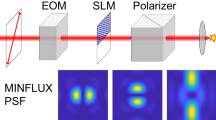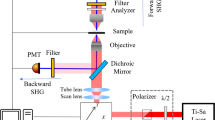Abstract
When Q-banded human chromosomes mounted in water are transferred to an organic mounting medium, the chromosomes show uniform bright quinacrine fluorescence. This change is reversible. It is inferred that quinacrine is bound uniformly along the chromosomes, and that Q-banding is a consequence of a non-uniform distribution along the chromosomes of chemical groups, probably proteinaceous, which affect the fluorescence efficiency of the bound quinacrine.
Similar content being viewed by others
References
Baker, J.R.: Principles of biological microtechnique. London: Methuen 1958
Evans, H.J., Buckton, K.E., Sumner, A.T.: Cytological mapping of human chromosomes: results obtained with quinacrine fluorescence and the acetic-saline-Giemsa technique. Chromosoma (Berl.) 35, 310–325 (1971)
Gottesfeld, J.M., Bonner, J., Radda, G.K., Walker, I.O.: Biophysical studies on the mechanism of quinacrine staining of chromosomes. Biochemistry 13, 2937–2945 (1974)
Kaye, G.W.C., Laby, T.H.: Tables of physical and chemical constants, 13th ed. London: Longman, Green and Co. Ltd. 1966
Löber, G., Kleinwächter, V., Koudelka, J., Balcarova, Z., Filkuka, J., Krejci, P., Döbel, P., Beensen, V., Rieger, R.: Molecular and spectroscopic aspects of chromosome banding. Biol. Zbl. 95, 169–191 (1976)
Pachmann, V., Rigler, R.: Quantum yield of acridines interacting with DNA of defined base sequence. A basis for the explanation of acridine bands in chromosomes. Exp. Cell Res. 72, 602–608 (1972)
Sumner, A.T.: Involvement of protein disulphides and sulphydryls in chromosome banding. Exp. Cell Res. 83, 438–442 (1974)
Sumner, A.T.: The role of proteins and dyes in chromosome banding. In: Chromosomes today (P.L. Pearson and K.R. Lewis, eds.), vol. 5, pp. 201–209. Jerusalem: Israel Universities Press 1976
Sumner, A.T., Evans, H.J.: Mechanisms involved in the banding of chromosomes with quinacrine and Giemsa. II. The interaction of the dyes with the chromosomal components. Exp. Cell Res. 81, 223–236 (1973)
Sumner, A.T., Mitchell, A.R., Gosden, J.R.: The relationship of nuclear quinacrine fluorescence to DNA base composition in the edible crab, Cancer pagurus. Cytobios 13, 151–165 (1975)
Udenfriend, S.: Fluorescence assay in biology and medicine. New York and London: Academic Press 1962
Udenfriend, S.: Fluorescence assay in biology and medicine, vol. 2. New York and London: Academic Press 1969
Weast, R.C.: Handbook of chemistry and physics, 53rd ed. Cleveland: The Chemical Rubber Co. 1972
Weisblum, B., de Haseth, P.L.: Quinacrine, a chromosome stain specific for deoxyadenylate-deoxythymidylate-rich regions in DNA. Proc. nat. Acad. Sci. (Wash.) 69, 629–632 (1972)
Author information
Authors and Affiliations
Rights and permissions
About this article
Cite this article
Sumner, A.T. Suppression of quinacrine banding of human chromosomes by mounting in organic media. Chromosoma 64, 337–342 (1977). https://doi.org/10.1007/BF00294941
Received:
Accepted:
Issue Date:
DOI: https://doi.org/10.1007/BF00294941




